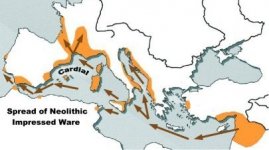We have discussed this topic extensively in various threads on the forum over the years, but there doesn't seem to be one thread dedicated to the subject. I will summarise my thoughts here so that I don't have to repeat myself every time.
As I have explained in my R1b history, between 2500 and 1800 BCE Western Europe was invaded by Bronze-age Indo-European speakers carrying mostly the R1b paternal lineage.
I could be believed that the Basques escaped this Indo-European invasion because they retained their non-IE language to this day. That is not the case.
In Iberia, it seems that the (Proto-)Celts of the early Bronze Age simply failed to impose their language not just over the Basque and Aquitanians, but also over all Mediterranean Iberia. In fact, there is no conclusive evidence that (Proto-)Celtic was spoken in Iberia before the Iron Age, with the La Tène expansion of the Celts to Northeast Iberia. Iberian was still spoken when the Romans arrived. It was the Romanisation that eventually obliterated Iberian language around the 2nd century.
I think it is very possible that all Iberia and Southwest France, and not just the Basques, kept their original Neolithic languages following the Bronze Age Indo-European invasions.
The survival of the indigenous language would have been the most likely scenario if the IE/R1b invaders were predominantly men. An army of adventurous Celtic men riding horses and equipped with bronze weapons could have butchered a substantial part of the Neolithic Iberian male population and taken their women. As good conquerors they would have taken many wives or concubines each (polygamy), having a great many children each, which helped the spread of R1b Y-DNA lineages (see How did R1b become dominant in Western Europe). Children, however, learn the language of the people who raise them, and these kinds of fathers would not have been able to take care of so many children. They would have concentrated on ruling their new land and enjoying their privileges, and left the education of their offspring to the (local) women.
After one, or a few, generation(s) their IE language would have completed disappeared, leaving only the previous Neolithic languages. It is possible, and even expected, that a few loanwords from (Proto-)Celtic entered the non-IE languages of Iberia and Southwest France to fill the gaps in vocabulary for new Bronze Age technologies brought by the Indo-Europeans. This is exactly what we see in the modern Basque vocabulary. I expect that the same happened to all other non-IE languages of the peninsula in the Bronze Age.
As I have explained in my R1b history, between 2500 and 1800 BCE Western Europe was invaded by Bronze-age Indo-European speakers carrying mostly the R1b paternal lineage.
I could be believed that the Basques escaped this Indo-European invasion because they retained their non-IE language to this day. That is not the case.
In Iberia, it seems that the (Proto-)Celts of the early Bronze Age simply failed to impose their language not just over the Basque and Aquitanians, but also over all Mediterranean Iberia. In fact, there is no conclusive evidence that (Proto-)Celtic was spoken in Iberia before the Iron Age, with the La Tène expansion of the Celts to Northeast Iberia. Iberian was still spoken when the Romans arrived. It was the Romanisation that eventually obliterated Iberian language around the 2nd century.
I think it is very possible that all Iberia and Southwest France, and not just the Basques, kept their original Neolithic languages following the Bronze Age Indo-European invasions.
The survival of the indigenous language would have been the most likely scenario if the IE/R1b invaders were predominantly men. An army of adventurous Celtic men riding horses and equipped with bronze weapons could have butchered a substantial part of the Neolithic Iberian male population and taken their women. As good conquerors they would have taken many wives or concubines each (polygamy), having a great many children each, which helped the spread of R1b Y-DNA lineages (see How did R1b become dominant in Western Europe). Children, however, learn the language of the people who raise them, and these kinds of fathers would not have been able to take care of so many children. They would have concentrated on ruling their new land and enjoying their privileges, and left the education of their offspring to the (local) women.
After one, or a few, generation(s) their IE language would have completed disappeared, leaving only the previous Neolithic languages. It is possible, and even expected, that a few loanwords from (Proto-)Celtic entered the non-IE languages of Iberia and Southwest France to fill the gaps in vocabulary for new Bronze Age technologies brought by the Indo-Europeans. This is exactly what we see in the modern Basque vocabulary. I expect that the same happened to all other non-IE languages of the peninsula in the Bronze Age.
Last edited:


